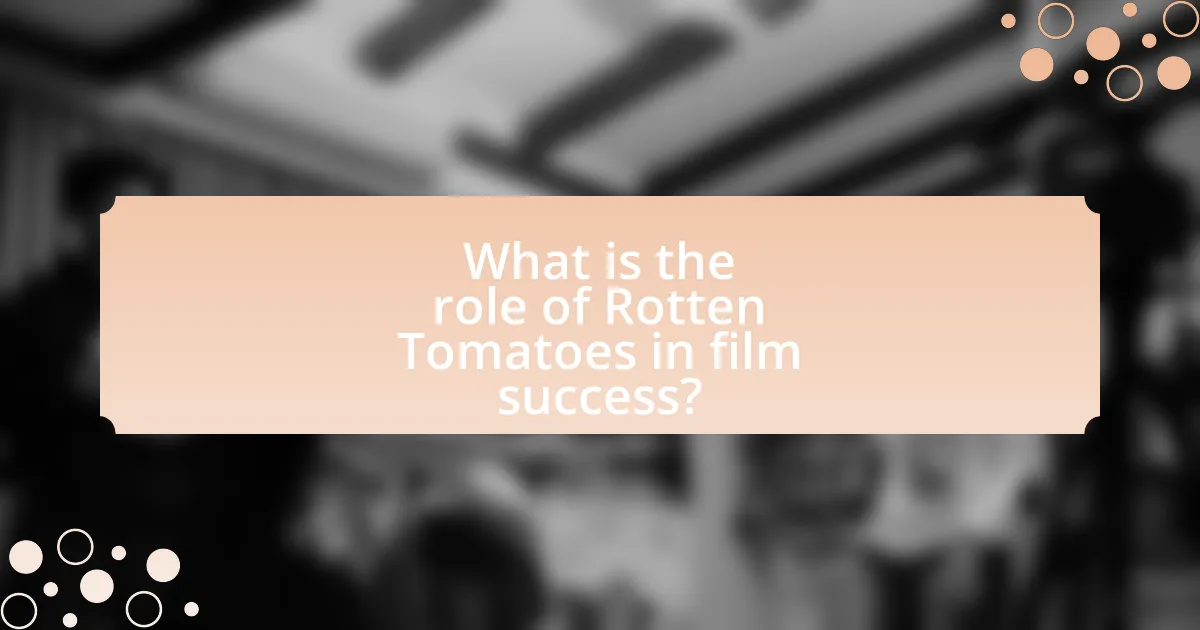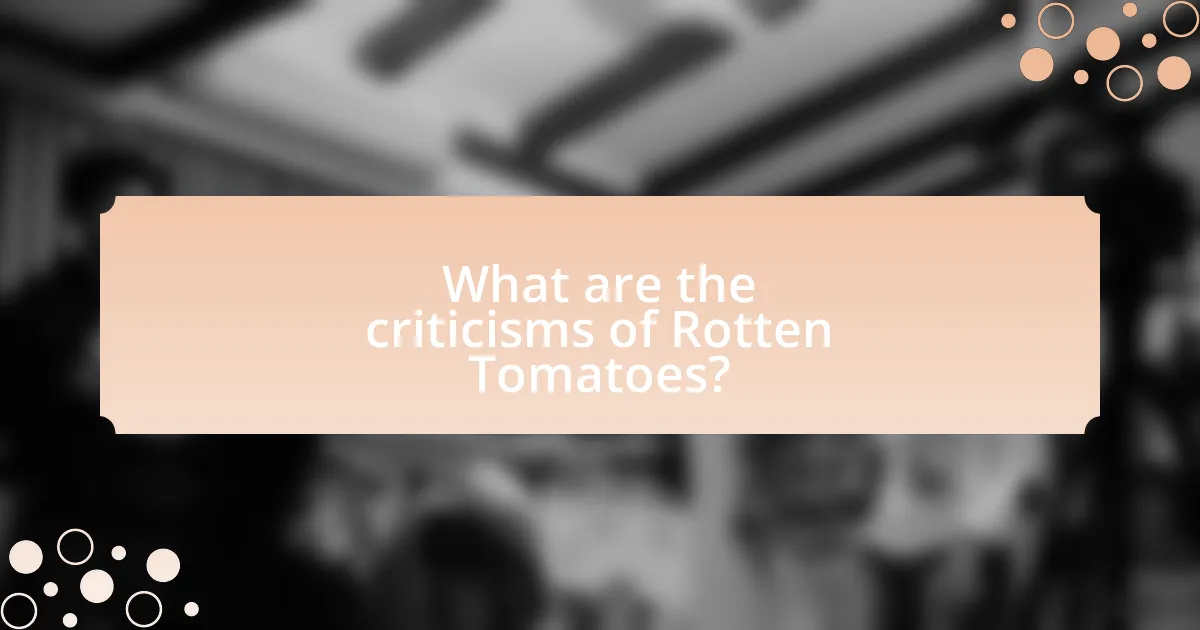Rotten Tomatoes is a critical platform in the film industry, significantly influencing film success through its aggregation of reviews and ratings. The Tomatometer score, which reflects the percentage of positive reviews from critics, serves as a key indicator of a film’s quality and directly impacts audience perceptions and box office performance. Research indicates that higher scores correlate with increased ticket sales, making Rotten Tomatoes an essential tool for filmmakers and studios in shaping marketing strategies and audience engagement. The article explores the metrics used by Rotten Tomatoes, the implications of its ratings on viewer decisions, and the criticisms surrounding its binary scoring system, while also examining future trends and best practices for filmmakers to leverage the platform effectively.

What is the role of Rotten Tomatoes in film success?
Rotten Tomatoes plays a significant role in film success by aggregating reviews and providing a score that influences audience perception and box office performance. The platform’s Tomatometer score, which reflects the percentage of positive reviews from critics, serves as a key indicator of a film’s quality, impacting viewers’ decisions to watch a movie. Research indicates that films with higher Rotten Tomatoes scores tend to achieve greater box office revenue; for instance, a study by the University of Southern California found that a 10% increase in the Tomatometer score correlates with a 5% increase in box office earnings. Thus, Rotten Tomatoes not only shapes critical reception but also directly affects commercial success in the film industry.
How does Rotten Tomatoes influence audience perceptions?
Rotten Tomatoes significantly influences audience perceptions by providing aggregated critic and audience scores that shape viewer expectations. The platform’s Tomatometer score, which reflects the percentage of positive reviews from critics, often serves as a benchmark for quality, leading potential viewers to form opinions based on these ratings. Research indicates that films with higher Tomatometer scores tend to attract larger audiences and generate more box office revenue, as seen in a study by the University of Southern California, which found that a 10% increase in the Tomatometer score correlates with a 5% increase in box office earnings. This demonstrates that Rotten Tomatoes not only informs but also sways audience decisions, reinforcing the importance of its ratings in the film industry.
What metrics does Rotten Tomatoes use to evaluate films?
Rotten Tomatoes evaluates films primarily using two metrics: the Tomatometer and the Audience Score. The Tomatometer reflects the percentage of professional critic reviews that are positive, while the Audience Score indicates the percentage of users who rated the film positively. These metrics are derived from aggregated reviews and ratings, providing a quantitative measure of a film’s reception. The Tomatometer is considered a key indicator of critical consensus, as it is based on reviews from approved critics, while the Audience Score captures the general public’s opinion, making both metrics essential for assessing a film’s overall success and appeal.
How do critics’ scores impact viewer decisions?
Critics’ scores significantly influence viewer decisions by shaping perceptions of a film’s quality and desirability. Research indicates that higher critics’ scores on platforms like Rotten Tomatoes correlate with increased box office revenue and viewer interest. For instance, a study by the University of Southern California found that films with a score above 75% on Rotten Tomatoes tend to earn 50% more at the box office compared to those with lower scores. This demonstrates that critics’ evaluations serve as a guiding factor for potential viewers, often swaying their choices toward films deemed critically acclaimed.
What is the significance of the Tomatometer?
The Tomatometer is significant as it serves as a critical metric for gauging the quality and reception of films based on aggregated reviews from critics and audiences. This rating system, developed by Rotten Tomatoes, influences consumer choices and can impact a film’s box office performance; for instance, films with a higher Tomatometer score often see increased ticket sales. Research indicates that a film rated “Fresh” (60% or higher) can lead to a substantial boost in viewership, demonstrating the Tomatometer’s role in shaping public perception and driving commercial success in the film industry.
How does the Tomatometer score affect box office performance?
The Tomatometer score significantly influences box office performance by affecting audience perception and decision-making. Higher scores typically correlate with increased ticket sales, as films rated positively are perceived as more appealing and trustworthy. For instance, a study by the University of California, Los Angeles, found that a 10% increase in the Tomatometer score can lead to a 5% increase in box office revenue. This relationship highlights how critical the Tomatometer score is in shaping consumer behavior and ultimately driving financial success for films.
What are the implications of a high or low Tomatometer score?
A high Tomatometer score indicates strong critical acclaim, which can lead to increased audience interest, higher box office revenue, and greater longevity in theaters. Conversely, a low Tomatometer score suggests poor critical reception, often resulting in diminished audience turnout, reduced box office performance, and a shorter theatrical run. Research shows that films with a Tomatometer score above 60% tend to perform better commercially, as evidenced by a study from the University of Southern California, which found that higher scores correlate with increased ticket sales.
How does Rotten Tomatoes affect filmmakers and studios?
Rotten Tomatoes significantly affects filmmakers and studios by influencing audience perceptions and box office performance. A high score on Rotten Tomatoes can enhance a film’s visibility and credibility, leading to increased ticket sales; for instance, films with a score above 70% often see a substantial boost in revenue compared to those with lower ratings. Additionally, Rotten Tomatoes serves as a critical metric for studios when making decisions about marketing strategies and potential sequels, as demonstrated by the correlation between positive reviews and audience turnout. This platform’s aggregation of critic and audience scores can ultimately shape a film’s legacy and the future projects of filmmakers.
What strategies do filmmakers use to improve their Rotten Tomatoes scores?
Filmmakers employ several strategies to improve their Rotten Tomatoes scores, primarily focusing on audience engagement and critical reception. They often conduct test screenings to gather feedback, allowing them to make adjustments before the official release. Additionally, filmmakers may engage with critics through press screenings and Q&A sessions, fostering positive relationships that can influence reviews. Marketing campaigns are also tailored to highlight favorable aspects of the film, aiming to attract a broader audience and generate buzz. For instance, films with strong social media presence and targeted advertising tend to perform better on Rotten Tomatoes, as they create anticipation and encourage early reviews. These strategies are supported by data showing that films with extensive pre-release marketing and positive critic interactions often achieve higher scores on the platform.
How do studios respond to Rotten Tomatoes ratings in marketing?
Studios respond to Rotten Tomatoes ratings in marketing by leveraging positive scores to enhance promotional efforts and attract audiences. For instance, high ratings are prominently featured in trailers, posters, and advertisements to build credibility and entice viewers, as evidenced by the marketing strategies of films like “Get Out,” which highlighted its 99% rating to boost ticket sales. Conversely, studios may downplay or avoid mentioning low ratings in their marketing materials, focusing instead on other aspects such as star power or audience reviews to mitigate potential negative impacts on box office performance. This strategic use of Rotten Tomatoes ratings reflects their significant influence on consumer perception and film success.

What are the criticisms of Rotten Tomatoes?
Criticisms of Rotten Tomatoes include its binary rating system, which oversimplifies complex reviews into a “fresh” or “rotten” designation, potentially misrepresenting a film’s quality. Critics argue that this system can lead to misleading perceptions, as a film with a majority of positive reviews may still receive a low score if the reviews are not overwhelmingly enthusiastic. Additionally, the aggregation of reviews from various sources can dilute individual critic opinions, making it difficult for audiences to gauge nuanced critiques. Furthermore, the platform has faced scrutiny for its handling of audience scores, with allegations of manipulation and the impact of online campaigns affecting ratings. These criticisms highlight concerns about the reliability and influence of Rotten Tomatoes in shaping public perception and film success.
Why do some filmmakers and critics oppose Rotten Tomatoes?
Some filmmakers and critics oppose Rotten Tomatoes because they believe its aggregation system oversimplifies complex film critiques into a binary score. This reductionist approach can misrepresent a film’s quality and nuance, leading audiences to make decisions based on misleading ratings rather than comprehensive reviews. For instance, a film that receives mixed reviews may end up with a low score, discouraging potential viewers despite positive aspects highlighted in individual critiques. This concern is supported by various filmmakers who argue that the platform’s focus on percentages undermines the art of filmmaking and the diversity of opinions within critical discourse.
What are the limitations of the Rotten Tomatoes scoring system?
The Rotten Tomatoes scoring system has several limitations, primarily its binary classification of reviews as either positive or negative, which oversimplifies the complexity of film critiques. This binary approach can lead to a misleading representation of a film’s quality, as it does not account for nuanced opinions that may fall in between. Additionally, the aggregation of scores from a diverse range of critics can result in a skewed average that does not reflect the consensus of audience reception. For instance, a film may receive a high percentage of positive reviews but still be poorly received by audiences, as seen with films that have high critic scores but low audience ratings. Furthermore, the system’s reliance on critic reviews can marginalize independent films that may not receive as much critical attention, thus affecting their visibility and success in the market.
How does the aggregation of reviews affect individual film narratives?
The aggregation of reviews significantly shapes individual film narratives by influencing audience perception and interpretation. When reviews are compiled on platforms like Rotten Tomatoes, they create a consensus that can either elevate or diminish a film’s perceived quality. For instance, a high aggregate score can lead audiences to view a film more favorably, often aligning their expectations with the prevailing critical narrative. Conversely, a low score can overshadow positive aspects of a film, leading viewers to focus on its shortcomings. Research indicates that films with higher aggregate ratings tend to perform better at the box office, demonstrating that collective reviews can alter the narrative surrounding a film’s success and reception.
How does Rotten Tomatoes impact film diversity?
Rotten Tomatoes impacts film diversity by providing a platform that can elevate underrepresented voices and stories through its rating system. The aggregation of critic and audience scores can influence which films receive funding and distribution, often favoring those with higher ratings. For instance, films featuring diverse casts or narratives that challenge mainstream norms may gain visibility if they achieve favorable scores, thereby encouraging studios to invest in similar projects. Additionally, the platform’s emphasis on audience engagement allows for a broader range of films to be recognized, as seen in the success of films like “Black Panther,” which received critical acclaim and high audience ratings, leading to increased interest in diverse storytelling within the industry.
What are the effects of Rotten Tomatoes on independent films?
Rotten Tomatoes significantly impacts independent films by influencing audience perception and box office performance. A high Tomatometer score can enhance visibility and credibility, leading to increased ticket sales and streaming views. For instance, films like “The Florida Project” and “Lady Bird” benefited from strong ratings, which contributed to their commercial success and award nominations. Conversely, a low score can deter potential viewers, limiting the film’s reach and profitability. Research indicates that 70% of moviegoers consult Rotten Tomatoes before deciding to watch a film, underscoring its role in shaping consumer choices in the independent film sector.
How does the platform influence genre representation in cinema?
The platform influences genre representation in cinema by shaping audience perceptions and expectations through aggregated reviews and ratings. Rotten Tomatoes, for instance, provides a score that can significantly impact a film’s visibility and perceived quality, often leading to genre films being categorized or marketed based on their critical reception. Research indicates that films with higher ratings tend to attract larger audiences, which can reinforce certain genres over others, as seen in the rise of superhero and horror films that receive favorable reviews. This dynamic creates a feedback loop where genre representation is influenced by the platform’s metrics, ultimately affecting production decisions and audience engagement.

What are the future trends for Rotten Tomatoes and film success?
Future trends for Rotten Tomatoes and film success indicate a growing reliance on audience engagement metrics and social media influence. As consumer behavior shifts towards valuing user-generated content, Rotten Tomatoes may enhance its focus on audience scores and reviews, reflecting a more democratic approach to film evaluation. Additionally, the integration of advanced analytics and machine learning could provide filmmakers and studios with deeper insights into viewer preferences, potentially guiding production and marketing strategies. This trend aligns with the increasing importance of data-driven decision-making in the film industry, as evidenced by the rise of streaming platforms that utilize viewer data to inform content creation.
How is Rotten Tomatoes adapting to changes in the film industry?
Rotten Tomatoes is adapting to changes in the film industry by expanding its metrics to include audience engagement and streaming data. This shift acknowledges the growing importance of digital platforms and viewer preferences, reflecting the industry’s transition towards streaming services and on-demand content. For instance, Rotten Tomatoes has introduced features like “Audience Score” and “Verified Ratings” to provide a more comprehensive view of a film’s reception, catering to the evolving landscape where traditional box office numbers are no longer the sole indicator of success.
What new features are being introduced to enhance user experience?
New features being introduced to enhance user experience on Rotten Tomatoes include personalized recommendations, improved search functionality, and enhanced user interface design. Personalized recommendations utilize algorithms to suggest films based on user preferences and viewing history, thereby increasing engagement. Improved search functionality allows users to filter results by various criteria such as genre, release date, and ratings, making it easier to find desired content. Enhanced user interface design focuses on creating a more intuitive and visually appealing layout, which has been shown to improve user satisfaction and retention rates.
How might Rotten Tomatoes evolve with the rise of streaming services?
Rotten Tomatoes may evolve by integrating more user-generated content and personalized recommendations in response to the rise of streaming services. As streaming platforms increasingly prioritize viewer engagement and tailored experiences, Rotten Tomatoes could enhance its aggregation of reviews and ratings by incorporating audience feedback directly from these services. This shift is supported by the growing trend of platforms like Netflix and Hulu, which utilize algorithms to suggest content based on user preferences, indicating a demand for more personalized viewing experiences. Additionally, Rotten Tomatoes might expand its metrics to include streaming-specific data, such as viewer retention rates and completion percentages, to provide a more comprehensive evaluation of a film’s success in the streaming landscape.
What best practices can filmmakers adopt regarding Rotten Tomatoes?
Filmmakers can adopt several best practices regarding Rotten Tomatoes to enhance their film’s visibility and reception. Firstly, they should actively engage with critics and encourage honest reviews, as a higher number of reviews can improve the film’s score and credibility on the platform. Research indicates that films with more than 100 reviews tend to have a more stable and favorable rating, as seen in the analysis of box office performance relative to Rotten Tomatoes scores. Additionally, filmmakers should consider timing their release strategically to avoid competition with major blockbusters, as this can influence the number of reviews and overall ratings. Lastly, utilizing social media to promote positive reviews can help shape public perception and drive audience interest, as films with strong online buzz often perform better in terms of ratings and box office success.
How can filmmakers effectively engage with audiences on Rotten Tomatoes?
Filmmakers can effectively engage with audiences on Rotten Tomatoes by actively participating in discussions, responding to reviews, and utilizing social media to promote their films. Engaging in discussions allows filmmakers to connect with viewers, showing appreciation for their feedback and fostering a community around their work. Responding to reviews, whether positive or negative, demonstrates that filmmakers value audience opinions, which can enhance viewer loyalty and interest. Additionally, leveraging social media platforms to share behind-the-scenes content, trailers, and updates can drive traffic to their Rotten Tomatoes page, increasing visibility and engagement. According to a study by the University of Southern California, films with higher engagement on social media platforms tend to perform better at the box office, highlighting the importance of audience interaction in film success.
What strategies can be employed to leverage Rotten Tomatoes for marketing?
To leverage Rotten Tomatoes for marketing, filmmakers and studios can utilize strategies such as highlighting high critic and audience scores in promotional materials, engaging with the Rotten Tomatoes community through social media, and using the platform’s verified audience ratings to build credibility. High scores on Rotten Tomatoes significantly influence consumer decisions; for instance, a study by the University of Southern California found that films with a score of 70% or higher on Rotten Tomatoes tend to perform better at the box office. Additionally, creating targeted advertising campaigns that showcase Rotten Tomatoes ratings can attract viewers who prioritize critical acclaim, thereby enhancing overall film visibility and success.